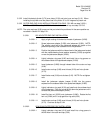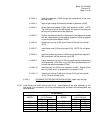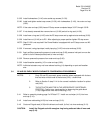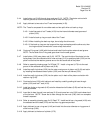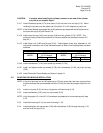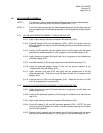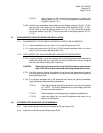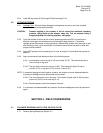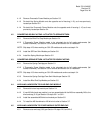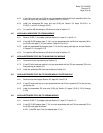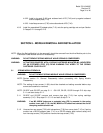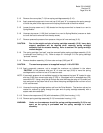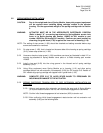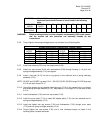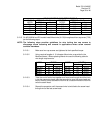
Bettis P/N 124840E
Revision “B”
Page 28 of 46
3.8.3 Install ES stop screw (5-50) through ES blind end cap (5-10).
3.9 ACTUATOR TESTING
3.9.1 Leakage Test - All areas where leakage to atmosphere may occur are to be checked,
using a commercial leak testing solution.
CAUTION: Pressure applied to the actuator is not to exceed the maximum operating
pressure rating listed on the actuator name tag. Test the actuator using a
properly adjusted self relieving regulator, with gauge.
3.9.2 Cycle the actuator five time at the nominal operating pressure (NOP) as listed on the
actuator name tag or the customers normal actuator supply pressure. If excessive
leakage across the pistons is noted, generally a bubble which breaks three seconds or less
after starting to form, cycle the actuator five times as this will allow the seals to seek their
proper service condition.
3.9.3 Apply NOP pressure to the pressure port in inner end cap (3-10) and allow the actuator to
stabilize.
3.9.4 Apply a commercial leak testing solution to the following areas:
3.9.4.1 Joint between inner end cap (3-10) and cylinder (3-70). This checks cylinder to
inner end cap o-ring seal.
3.9.4.2 The port hole in the outer end cap (3-80). This checks the piston D-seal to
cylinder (3-70), o-ring seal (4-70), and rod T seal (4-50).
NOTE: If excessive leakage across the piston remains, the actuator must be disassembled and
the cause of leakage must be determined and corrected.
3.9.4.3 The vent check port hole in housing. This checks Polypak seal (4-30) that seals
piston rod (3-40) to inner end cap (3-10).
3.9.4.4 Remove pressure from the pressure inlet port.
3.9.5 If an actuator was disassembled and repaired, the above leakage test must be performed
again.
SECTION 4 - FIELD CONVERSIONS
4.1 FAIL MODE REVERSAL (CW TO CCW, OR CCW TO CW)
4.1.1 Remove Spring Module per Section 5.1.



